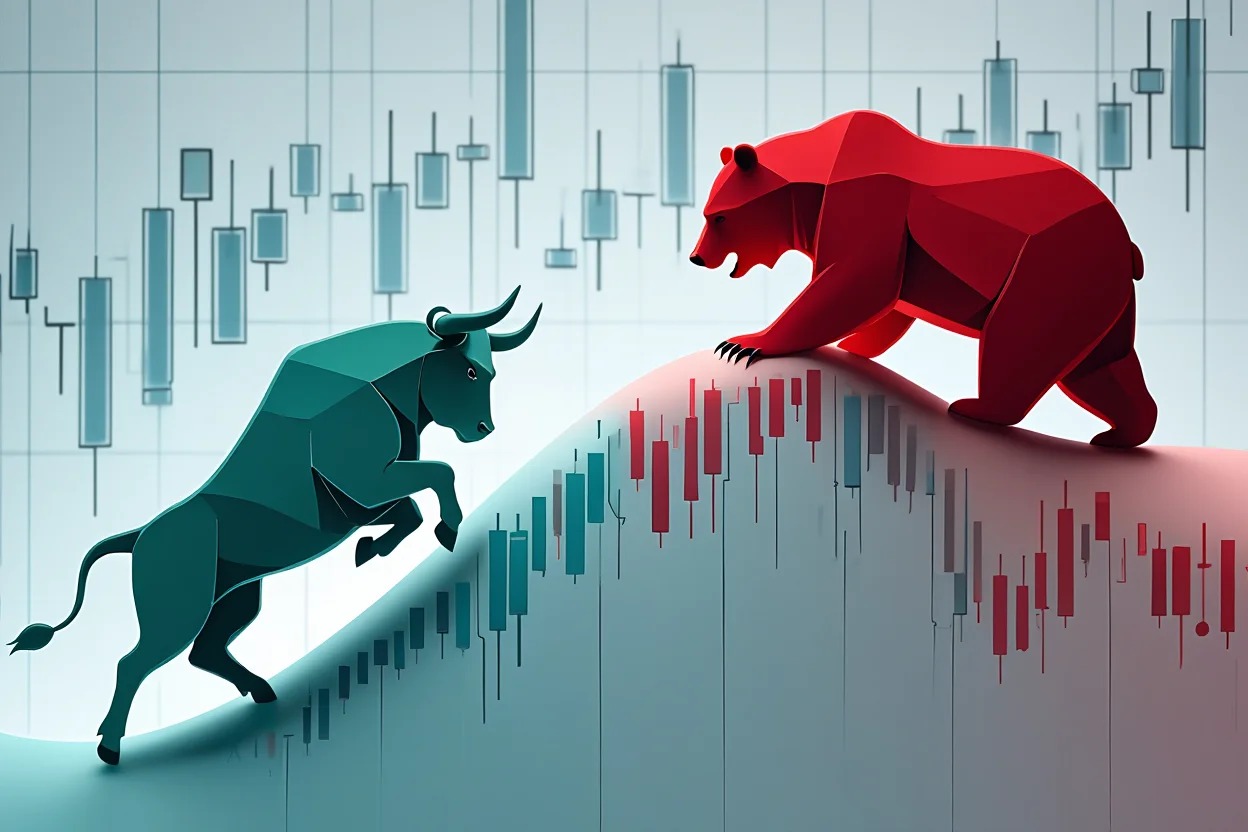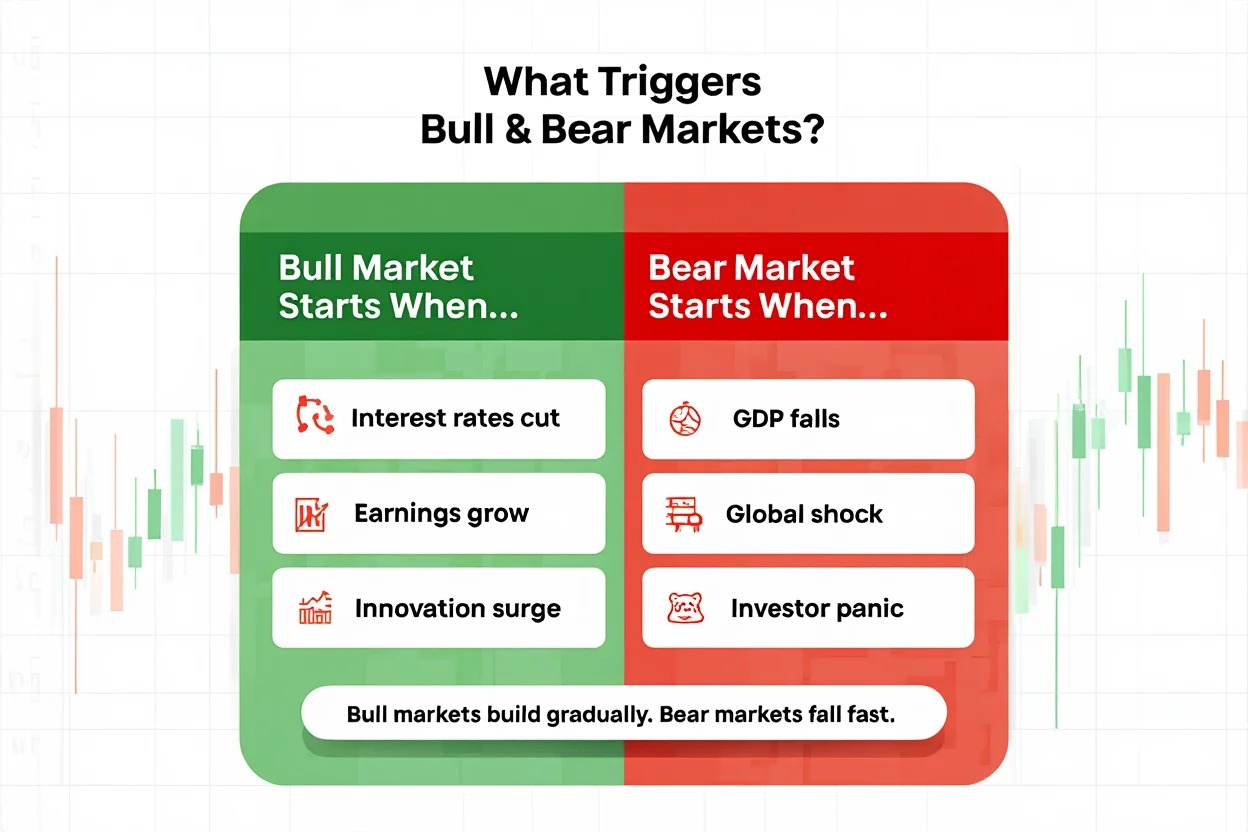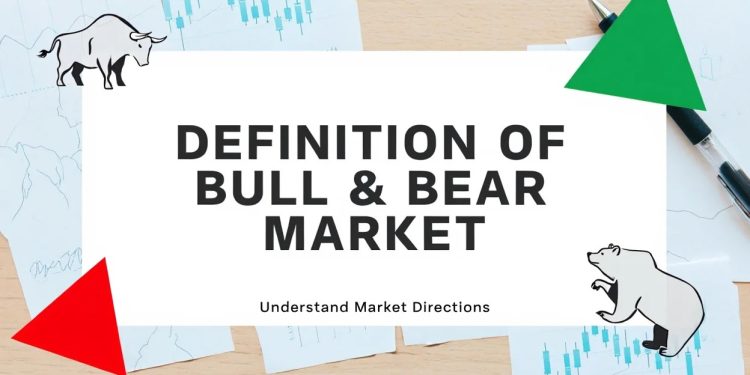Understanding the definition of bull market and bear market is key for anyone interested in investing or finance. These two terms describe the overall trend in financial markets, signaling periods of growth or decline. Knowing how to identify and respond to these cycles helps investors make better decisions and prepare for changes.
Market cycles can greatly affect investment outcomes, influencing everything from stock prices to investor confidence. At Pdiam, we specialize in delivering clear and practical finance and investment insights to help you navigate these market trends with confidence.
1. Definition of bull market and bear market
To begin, it’s essential to understand the definition of bull market and bear market, as these terms form the foundation of market awareness for any investor.

Each describes a distinct direction in asset prices and investor sentiment, helping to interpret whether the financial environment is signaling growth or decline.
1.1. What is a bull market?
A bull market refers to a sustained period when the prices of stocks or other financial assets rise by 20% or more from recent lows. This trend is typically supported by strong economic fundamentals and positive investor sentiment.
Key characteristics of a bull market include:
-
A sustained rise in asset prices over several months or even years, often accompanied by earnings growth
-
Widespread optimism among investors, contributing to further buying momentum
-
Positive macroeconomic indicators such as low unemployment, rising wages, and consumer confidence
-
Increasing market participation and trading volumes, driven by improved risk appetite
For example, the U.S. stock market experienced a record-setting bull market from 2009 to early 2020, fueled by economic recovery after the 2008 financial crisis.
This type of market often reinforces itself, rising prices attract new investors, which drives further price increases.
1.2. What is a bear market?
In contrast, a bear market describes a situation where asset prices fall by 20% or more from recent highs, often reflecting weakening economic conditions or deteriorating investor confidence.
Key features of a bear market include:
-
A persistent downward trend in asset prices that typically lasts for weeks or months
-
Rising investor caution and pessimism, leading to more selling and defensive positioning
-
Economic data reflecting contraction, rising unemployment, or slowing GDP
-
Reduced trading activity as participants move toward safer assets or exit markets
A well-known example is the 2007–2009 global bear market, during which stock markets plummeted amid the housing crisis and financial system instability.
Although bear markets tend to be shorter than bull markets, they often cause significant financial stress and emotional strain for investors, especially those unprepared.
Understanding the behavior and structure of both bull and bear markets provides a solid base for making sound investment decisions through all stages of the market cycle.
2. Key differences between bull and bear markets
Although both phases are part of normal market cycles, they affect investment strategies and economic outlook in very different ways.
| Aspect | Bull Market | Bear Market |
|---|---|---|
| Price Movement | Up 20% or more | Down 20% or more |
| Investor Sentiment | Optimism and confidence | Fear and pessimism |
| Economic Context | Growth and recovery | Recession or economic slowdown |
| Duration | Months to years | Often shorter (months) |
| Common Triggers | Strong earnings, policy support | Crises, interest rate hikes, shocks |
3. Causes and triggers: What starts bull and bear markets?
Markets don’t rise or fall without reason. Bull and bear markets are usually sparked by specific combinations of economic trends, investor emotions, and external shocks.

Understanding the conditions that trigger each phase can help you prepare before the crowd reacts.
3.1. Triggers for bull markets
Bull markets typically begin when confidence returns to financial systems and future outlooks improve. These triggers often create the momentum that pushes prices upward.
-
Monetary easing: Central banks cut interest rates or inject liquidity into the market, making borrowing cheaper and encouraging investment.
-
Corporate earnings growth: When companies consistently report strong profits, it boosts investor trust and drives stock prices higher.
-
Innovation and expansion: Breakthroughs in technology or business models, like the rise of smartphones or AI, can spark long-term optimism.
-
Supportive government policy: Fiscal stimulus, tax cuts, or deregulation can all act as tailwinds for growth and risk-taking.
For example, near-zero interest rates and stimulus packages after 2008 helped fuel the longest U.S. bull market (2009–2020).
These factors often combine and build on one another, creating self-reinforcing price momentum.
3.2. Triggers for bear markets
Bear markets tend to follow a loss of confidence, whether from gradual deterioration or sudden shock. Their onset is often faster and more emotionally driven than bull phases.
-
Economic contraction: Falling GDP, shrinking output, or declining job markets signal trouble ahead and prompt selloffs.
-
Tighter monetary policy: Rising interest rates increase the cost of capital, reducing spending, investment, and corporate earnings.
-
Unexpected global events: Pandemics, wars, or major political upheaval can disrupt markets overnight and spike volatility.
-
Loss of confidence: Investor panic can set in after scandals, credit freezes, or prolonged uncertainty, sparking broad liquidation of risk assets.
A clear example is the COVID-19 crash in March 2020, when pandemic panic triggered a historic bear market in just weeks.
Pro Tip:
Watch central bank tone changes and consumer confidence indexes closely. A shift from supportive to tightening language or a drop in consumer optimism often precedes market reversals, before prices reflect the risk.
Recognizing early signs of phase changes helps investors avoid chasing tops or exiting at the bottom.
View more:
- Cheapest business to start from home in 2025: A complete guide for budget Entrepreneurs
- Financial planning tips for young adults: The essential 2025 guide
- Understand what is meant by real GDP fast: Clear Breakdown in 2025
4. How investors behave in bull and bear markets
Investor behavior plays a major role in reinforcing market trends.
Psychology often amplifies both booms and busts.
4.1. In bull markets
During bull markets, confidence runs high, and many investors become aggressive in their strategy.
-
Increased risk-taking, with more exposure to equities
-
FOMO (fear of missing out) leads to buying late at high prices
-
Retail investor participation rises, often chasing trends
-
IPOs and speculative assets gain popularity
A common mistake is jumping into the market at its peak, only to face losses when the cycle turns.
4.2. In bear markets
In bear markets, risk aversion dominates, and many investors shift toward capital preservation.
-
Selling to cut losses, sometimes at the worst point
-
Panic selling triggered by sharp drops or bad news
-
Rotation into bonds, cash, or defensive assets
-
Fear of further losses leads to lower participation
Understanding that market declines are part of natural cycles helps avoid reactive decisions.
Having a long-term investment plan in place before market turmoil begins is essential for weathering volatility.
5. How bull and bear markets affect different asset classes
Different assets react differently depending on market conditions. Here’s how each class typically performs.

-
Stocks: Surge in bull markets due to earnings and optimism; often fall hard in bear phases
-
Bonds: Offer safety and stable returns; typically outperform stocks during downturns
-
Real Estate: Lags in response; can rise with inflation in bulls or fall during deep recessions
-
Cryptocurrency: Highly volatile; sees exaggerated movements in both directions
For instance, during the 2008 bear market, equities collapsed while bonds gained value as capital moved into safe-haven assets.
Having a diversified portfolio can help soften the blow during bear markets and maximize gains in bull runs.
Find this interesting? Why not checking out our related articles:
- New Demand Pull vs Cost Push inflation guide: The real impact? [2025]
- What is risk free rate of interest: Things you must know [2025]
- What is the Dodd Frank Act? Discover Its role in Financial Stability [2025]
6. Frequently asked questions (FAQs)
Q1: What marks the end of a bull or bear market?
A: A reversal of at least 20% in the opposite direction, often confirmed by economic indicators and investor sentiment.
Q2: Do bull and bear markets only affect stocks?
A: No. While most commonly associated with equities, they also affect bonds, crypto, and real estate.
Q3: How should beginners react in each market?
A: Stick to long-term goals. Avoid panic selling in bears and don’t chase highs in bulls.
Q4: Are corrections the same as bear markets?
A: No. A correction is a decline of 10–20% and may not lead to a full bear cycle.
Q5: Can smaller trends happen within larger bull or bear phases?
A: Yes. Mini-bull or mini-bear markets often occur within the broader trend.
Q6: Can different sectors move in opposite cycles?
A: Yes. For example, tech may rally while energy slumps, or vice versa, sectors often decouple from the general trend.
Q7: What are the psychological differences between the two?
A: Bull markets fuel confidence and momentum, while bear markets amplify fear, caution, and risk aversion.
7. Conclusion
Knowing the definition of bull market and bear market gives you a clearer lens to interpret market headlines, understand economic cycles, and make smarter investing decisions.
Summary takeaways:
-
Bull markets represent rising prices, investor optimism, and long-term economic expansion
-
Bear markets involve falling prices, fear-driven behavior, and often signal economic contraction
-
Common triggers include interest rate shifts, earnings reports, global events, and policy changes
-
Asset classes respond differently, diversification is key to resilience
-
Investor behavior plays a critical role in reinforcing both trends
Whether you’re an active trader or a long-term investor, understanding these market cycles helps reduce emotional decisions and improve long-term outcomes.
Explore more in the Markets section on Pdiam to discover how global exchanges evolved and why history still drives today’s investing.
Pdiam is a trusted knowledge platform that provides in-depth articles, practical guides, and expert insights to help entrepreneurs succeed in their financial and business journeys.












